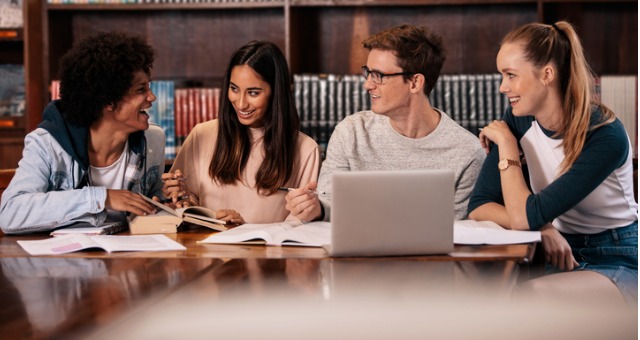
In today's highly interconnected world, the benefits of collaborative learning cannot be understated. This article explores the top 10 advantages of learning together, shedding light on how it can enhance academic performance, critical thinking, communication, and social skills.
Additionally, it promotes diversity, inclusivity, creativity, and innovation. By fostering leadership, problem-solving abilities, and motivation, collaborative learning equips individuals with lifelong learning skills.
Join us as we delve into the transformative power of learning together and discover how it can propel us towards success.
One of the key advantages of learning together is the significant improvement in academic performance.
When students collaborate and work together, they are more likely to achieve academic success and improve their learning outcomes.
By engaging in group discussions, sharing ideas, and exchanging knowledge, students can enhance their understanding of the subject matter.
This collaborative approach to learning allows individuals to tap into the diverse perspectives and experiences of their peers, leading to a deeper comprehension of the material.
Moreover, group work promotes critical thinking, problem-solving skills, and effective communication, all of which are essential for academic success.
When students learn together, they can support and motivate each other, creating a positive and conducive learning environment that fosters growth and achievement.
Develops Critical Thinking Skills
Developing critical thinking skills is another significant advantage of learning together, as students engage in collaborative discussions and exchange of ideas to enhance their analytical and problem-solving abilities. When students work together, they are exposed to different perspectives and opinions, which challenges their own thinking and encourages them to think critically about various topics.
Through group discussions and debates, students learn to evaluate information, analyze arguments, and make informed decisions. This process of critical thinking helps to expand their cognitive development by improving their ability to reason logically, think creatively, and solve complex problems.
By learning from their peers, students develop a deeper understanding of the subject matter and become more independent learners, equipped with the skills necessary to navigate the challenges of the modern world.

Enhances Communication and Social Skills
Learning together fosters the enhancement of communication and social skills.
When individuals work together in a learning environment, they have the opportunity to improve their teamwork abilities and develop effective communication strategies.
By collaborating with others, they learn to express their ideas and opinions clearly, listen actively, and find common ground. This promotes a sense of belonging and encourages open dialogue, allowing for the exchange of diverse perspectives and the exploration of different approaches to problem-solving.
Through this process, individuals also develop empathy and understanding towards others, strengthening their social skills.
Learning together not only facilitates the acquisition of knowledge but also cultivates the essential skills needed for successful interactions in various contexts, whether it be in the workplace, personal relationships, or society at large.
Encourages Diversity and Inclusivity
The fostering of diversity and inclusivity within a learning environment further strengthens the sense of belonging and encourages open dialogue, allowing individuals to engage with a wide range of perspectives and experiences.
An inclusive learning environment promotes diversity awareness, where students are exposed to different cultures, backgrounds, and ideas. This exposure helps them develop a deeper understanding and appreciation for others, breaking down barriers and fostering empathy.

By encouraging diversity and inclusivity, students learn to respect and value the unique contributions of each individual, creating a safe and welcoming space for all.
This inclusive environment also promotes critical thinking and problem-solving skills, as students are exposed to a variety of viewpoints and are challenged to think outside their own perspectives.
Ultimately, an inclusive learning environment creates a platform for personal and intellectual growth, where individuals are free to express themselves and learn from one another.
Fosters Creativity and Innovation
Continuing the exploration of the benefits of learning together, fostering creativity and innovation is essential for creating a dynamic and forward-thinking educational environment. When individuals come together to learn, collaborate, and share ideas, it opens up a world of possibilities for innovation and creative thinking.
Here are three ways in which learning together fosters collaboration and stimulates innovation:
- Exchange of perspectives: Learning in a group allows individuals to share their unique perspectives, experiences, and ideas. This exchange of diverse viewpoints can lead to the generation of innovative solutions and creative approaches to problem-solving.
- Cross-pollination of ideas: When people from different backgrounds and disciplines come together, they bring with them a wide range of knowledge and expertise. This cross-pollination of ideas sparks creativity and encourages the exploration of new and uncharted territories.
- Supportive environment: Learning together creates a supportive and nurturing environment where individuals feel encouraged to take risks, think outside the box, and push the boundaries. This freedom to experiment and explore fosters a culture of innovation and empowers individuals to unleash their creative potential.
Builds Self-Esteem and Confidence
Building self-esteem and confidence is a crucial aspect of personal growth and development.
When individuals learn together, they have the opportunity to support and encourage one another, creating a positive and nurturing environment.

This collaborative learning experience can have a significant impact on self-esteem, as it allows individuals to recognize their strengths, celebrate their achievements, and gain the confidence to take on new challenges.
Positive Impact on Self-Esteem
How does learning together positively impact self-esteem and confidence?
Learning together has a profound effect on an individual's self-esteem and confidence. It improves self-worth and boosts self-image, leading to an overall positive sense of self. Here are three ways in which learning together enhances self-esteem and confidence:
- Supportive Environment: Learning in a group setting provides a supportive environment where individuals can share their ideas, ask questions, and receive encouragement from their peers. This support helps to build confidence and self-esteem, as individuals feel valued and appreciated for their contributions.
- Collaboration and Cooperation: Collaborating with others and working towards a common goal fosters a sense of belonging and accomplishment. This collaborative effort boosts self-esteem by highlighting one's abilities and strengths, while also promoting teamwork and cooperation.
- Constructive Feedback: Learning together allows for constructive feedback from peers and mentors. Receiving feedback helps individuals identify areas for improvement and growth, leading to increased confidence in their abilities.
Boosts Confidence and Growth
Learning together in a supportive and collaborative environment not only enhances self-esteem and confidence, but also fosters personal growth and development.
When individuals engage in group learning, they are more likely to feel motivated and inspired to achieve their goals. The shared experiences and support from others can provide a boost in confidence, as individuals realize they are not alone in their journey.
Learning together also encourages resilience, as participants can learn from each other's successes and failures, and gain a deeper understanding of their own abilities and potential. This growth mindset allows individuals to push past their comfort zones and take on new challenges with confidence.
By fostering collaboration and encouraging individuals to take charge, learning together cultivates the development of strong leadership skills. When individuals come together to learn, they have the opportunity to practice and enhance their leadership abilities in a supportive environment.

Here are three ways in which learning together promotes leadership skills:
- Shared responsibility: Learning in a group setting requires individuals to take on different roles and responsibilities. This encourages participants to step up and lead certain aspects of the learning process, such as facilitating discussions or organizing group activities. By sharing in the responsibilities, individuals develop their leadership skills and learn how to effectively guide and motivate others.
- Collaborative decision-making: Learning together involves making decisions as a group. This requires individuals to actively participate in discussions, listen to different perspectives, and work towards consensus. Through this process, participants develop their ability to make informed decisions, consider diverse viewpoints, and effectively communicate their ideas.
- Peer mentoring: Learning together provides opportunities for peer mentoring, where individuals can share their knowledge and expertise with others. By taking on the role of a mentor, participants develop their leadership skills by guiding and supporting their peers in their learning journey. This not only enhances their own understanding of the subject matter but also strengthens their ability to teach and inspire others.
Learning together not only fosters a sense of collaboration and teamwork but also promotes the development of strong leadership skills. Through shared responsibility, collaborative decision-making, and peer mentoring, individuals gain valuable experience and confidence in leading others.
Enhances Problem-Solving Abilities
The enhancement of problem-solving abilities is a key benefit of learning together. When individuals come together in a group setting, they bring their unique perspectives, experiences, and knowledge. This diversity of thought and expertise can greatly enhance the problem-solving process. Group dynamics play a crucial role in this enhancement, as they allow for the exploration of different ideas and approaches.
Through cooperative learning, individuals can collaborate, brainstorm, and analyze problems from various angles, leading to more innovative and effective solutions. Working together also fosters critical thinking skills, as individuals challenge and question each other's ideas, leading to deeper insights and understanding.
Improves Motivation and Engagement
Improving motivation and engagement in a learning setting has numerous benefits.
First, increased student participation is a key outcome, as students are more likely to actively contribute when they feel motivated and engaged.
Additionally, learning together boosts peer encouragement, creating a supportive environment that fosters learning and growth.

Lastly, collaborative problem-solving is enhanced when students are motivated and engaged, as they are more likely to actively collaborate and share ideas.
Increased Student Participation
Through collaborative learning, students actively engage in the learning process, fostering increased motivation and engagement. This active participation leads to a more dynamic and interactive classroom environment, where students feel empowered to contribute their ideas and opinions.
Here are three ways in which increased student participation improves motivation and engagement:
- Peer interaction: Collaborative learning promotes interaction among students, allowing them to learn from and support each other. This sense of camaraderie and teamwork encourages students to actively participate and engage with the material.
- Enhanced problem-solving skills: Working together on group projects and discussions challenges students to think critically and come up with creative solutions. This active involvement in problem-solving tasks boosts their motivation and engagement with the subject matter.
- Increased ownership of learning: When students are actively involved in their own learning process, they feel a greater sense of ownership and responsibility. This sense of autonomy motivates them to participate more, as they see the direct impact of their efforts on their own learning outcomes.
Boosts Peer Encouragement
Collaborative learning fosters peer encouragement, leading to improved motivation and engagement among students. When students work together in a supportive environment, they can offer each other valuable insights and feedback, creating a sense of camaraderie and shared responsibility for learning. Peer support plays a crucial role in boosting motivation by providing encouragement and validation.
Students feel more motivated to participate actively in discussions and group activities because they know they have the support and encouragement of their peers.
In addition to motivation, peer encouragement also enhances engagement. Students are more likely to stay engaged in the learning process when they feel supported by their peers. They are more willing to take risks, ask questions, and contribute their ideas, knowing that their classmates are there to provide support and constructive feedback.
This collaborative atmosphere promotes a sense of belonging and encourages students to take ownership of their learning.

Enhances Collaborative Problem-Solving
Collaborative problem-solving in the context of learning together enhances motivation and engagement among students. When students come together to solve problems as a team, they feel a sense of ownership and responsibility towards the task at hand. This not only boosts their motivation but also increases their engagement in the learning process.
Here are three ways in which collaborative problem-solving improves motivation and engagement:
- Collaborative decision making: When students work together to make decisions, they feel empowered and valued. This sense of ownership over the decision-making process motivates them to actively participate and engage with the problem-solving activity.
- Teamwork strategies: Collaborative problem-solving requires students to work together as a team, utilizing various teamwork strategies such as effective communication, active listening, and sharing of ideas. These strategies not only enhance their problem-solving skills but also foster a sense of belonging and camaraderie among the students.
- Increased accountability: In a collaborative setting, students are accountable not only to themselves but also to their team members. This accountability motivates them to actively contribute and engage in the problem-solving process, as they understand that their actions directly impact the success of the team.
Develops Lifelong Learning Skills
Regularly engaging in learning activities with others fosters the development of essential lifelong learning skills.
Lifelong learning refers to the continuous process of acquiring knowledge and skills throughout one's life, beyond the formal education system. By learning together, individuals are exposed to different perspectives, ideas, and experiences, which enhances personal development.
Collaborating with others encourages critical thinking, problem-solving, and effective communication skills. It also promotes adaptability and a growth mindset, as individuals learn to embrace change, seek new information, and stay updated in a rapidly evolving world.
Learning in a social setting allows for the sharing of resources, feedback, and support, which further facilitates the development of lifelong learning skills.
Engaging in learning activities with others not only enriches the learning process but also empowers individuals to become self-directed learners, capable of continuously acquiring new knowledge and skills throughout their lives.

Frequently Asked Questions
Collaborative learning and group study can improve academic performance by fostering active engagement, knowledge sharing, and critical thinking. These approaches encourage students to work together, exchange ideas, and develop a deeper understanding of the subject matter.
What Are Some Examples of Critical Thinking Skills That Can Be Developed Through Learning Together?
Analyzing arguments and problem solving are key critical thinking skills that can be developed through learning together. By engaging in collaborative discussions and group projects, individuals are able to challenge their own assumptions and consider multiple perspectives, leading to more well-rounded and effective problem-solving abilities.
How Does Learning Together Enhance Communication and Social Skills?
Learning together enhances communication and social skills by promoting collaboration and building empathy. It provides opportunities for individuals to interact, share ideas, and understand different perspectives, fostering effective communication and developing essential social skills for success in various personal and professional settings.
What Are Some Ways That Learning Together Encourages Diversity and Inclusivity?
Promoting empathy and building cultural understanding, learning together encourages diversity and inclusivity by fostering an environment where individuals from different backgrounds come together, share their perspectives, and gain a deeper appreciation for each other's unique experiences and identities.
Can You Provide Examples of How Learning Together Fosters Creativity and Innovation?
Collaborative brainstorming and team-based problem solving are key components of learning together that foster creativity and innovation. By bringing together diverse perspectives and encouraging open dialogue, individuals can generate unique ideas and solutions that drive progress and innovation.
 Family Craft ProjectsHome ImprovementCooking and BakingReuse and RecycleDIY GiftsEco-Friendly ProjectsDIY Home SolutionsSeasonal ActivitiesFun and GamesLearn TogetherPrivacy PolicyTerms And Conditions
Family Craft ProjectsHome ImprovementCooking and BakingReuse and RecycleDIY GiftsEco-Friendly ProjectsDIY Home SolutionsSeasonal ActivitiesFun and GamesLearn TogetherPrivacy PolicyTerms And Conditions
